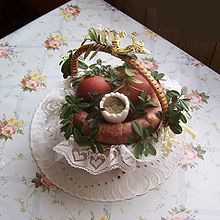Easter food
The holiday of Easter is associated with various Easter customs and foodways (food traditions that vary regionally). Preparing, coloring, and decorating Easter eggs is one such popular tradition.
Some regional Easter dishes[]
In Greece, the traditional Easter meal is mageiritsa, a hearty stew of chopped lamb liver and wild greens seasoned with egg-and-lemon sauce. Traditionally, Easter eggs, hard-boiled eggs dyed bright red to symbolize the spilt Blood of Christ and the promise of eternal life, are cracked together to celebrate the opening of the Tomb of Christ.
In Neapolitan cuisine, the main Easter dishes are the casatiello or , a savoury pie made with bread dough stuffed with various types of salami and cheese, also used the day after Easter for outdoor lunches. Typical of Easter lunches and dinners is the fellata, a banquet of salami and capocollo and salty ricotta. Typical dishes are also lamb or goat baked with potatoes and peas. Easter cake is the pastiera.
In Russia, red eggs, kulich and paskha are Easter traditions.
In Serbia, paretak are traditional Easter pastries.
In Ukraine, there are several traditional Easter foods including paska (bread) and cheesecake desserts.[1]
List of Easter foods[]


Other Easter foods and food traditions include:
- Akvavit
- Awara broth, in French Guiana
- Babka (cake)
- Butter lamb
- Cadbury egg
- Carrot cake
- Chakapuli
- Colomba di Pasqua
- Cozonac
- Easter biscuit
- Easter bread
- (see Polish cuisine#Easter breakfast)
- Easter bunny (often of the chocolate variety)
- Easter eggs
- Red Easter eggs
- Hot cross bun
- Fanesca, in Ecuador
- Feseekh, in Egypt
- Flaouna
- Koulourakia
- Kulich
- Leib
- Mämmi
- Ma'amoul
- Mazurek (cake)
- and "Folar" in Portugal
- Paretak pastries
- Paska (bread)
- Paskha
- Pastiera
- Pesaha Appam
- Pinca
- Peeps
- Pogaca (bread)
- Salted herring
- Sárgatúró in Hungary
- Simnel cake
- Šoldra
- Święconka
- Tsoureki, sometimes lined with red Easter eggs
See also[]
- Chiviri
- Fat Tuesday
- Passover
- Pisanica (Croatian)
- Śmigus-Dyngus
References[]
- Easter food